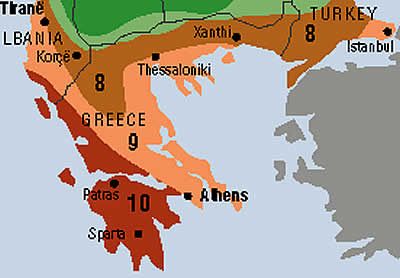A Hardiness Zone is a geographically defined area in which a specific category of plants can grow, based on the climatic conditions prevailing. The climatic conditions that a plant can tolerate include the ability to withstand the minimum temperatures of the zone. See the table below.
| Zone | Temperature (Celsius degrees) |
| – | 10 |
| 11 | 4 |
| 10 | -1 |
| 9 | -7 |
| 8 | -12 |
| 7 | -17 |
| 6 | -23 |
| 5 | -29 |
| 4 | -35 |
| 3 | -40 |
| 2 | -45 |
| 1 | -51 |
For example, a plant described as “zone 10 tolerant” means that the plant can withstand a minimum temperature of -1 degrees Celsius. A more hardy plant that is “zone 9 hardy” can withstand a minimum temperature of -7 degrees Celsius. Hardiness zones were originally developed for the U.S. by the Department of Agriculture, but their use has been expanded to other countries.
Advantages and disadvantages
Hardiness zones serve informational purposes. Lower winter temperatures are important information about whether a plant species can be grown outdoors in a particular location. However, hardiness zones have a number of disadvantages if used without additional information.
Hardiness zones do not include summer temperature levels. Thus areas that have the same average minimum temperature in winter, but significantly different high temperatures in summer, will be recorded in the same hardiness zone.
Another issue is that the hardiness zones do not take into account the effect of a stable snowpack. Snow acts as an insulator against very cold temperatures, protecting the root system of hibernating plants. If the snow layer is of considerable thickness and is maintained for most of the winter period, the actual temperature to which the roots are exposed will not be as low as the hardiness zone indicates.
Other parameters that affect plant survival but are not taken into account in the hardiness zones are soil moisture, humidity, how many days it freezes and the risk of sudden (downward) temperature changes. Sometimes knowing the likelihood of steep downward temperature changes is more important than knowing the average minimum temperature in a place.
Finally, many plants can survive in an area but will not flower if the night length is not long enough or chill hours are not enough also. For annuals, the time of sowing can be adjusted to allow for growth beyond their normal range.
An alternative way of describing plant hardiness is to use “plants as indicators”. In this method, common plants with known limits in the areas where they thrive are used.
Hardiness zones in Greece
Searching the internet, I have not found any reliable information or map describing the resistance zones in Greece. I do not even know if there is such a division of the Greek territory.
The only map I found comes from https://www.houzz.com/europeZoneFinder. Apparently it is a general map as none of the Greek islands are shown.

Based on this map, we see that Greece is divided into 3 hardiness zones.
– Part of Northern Greece belongs to hardiness zone 8.
– Central Greece, including Attica and Evia, belongs to hardiness zone 9.
– Western Greece and the Peloponnese belong to the resistance zone 10.
I believe that more reliable information on the hardiness zones would be obtained if we followed the ‘indicator plants’ method. In this way we would know which plants thrive in which areas.
But even this method might not be completely reliable. Greece, because of its relief, has microclimates that overturn the observations of a general zone.
How about starting a survey of the plants that thrive in the places you come from?
Empirically, it would be the safest way to create a map of hardiness or thriving zones.
Tags: GREECE • HARDINESS ZONES


